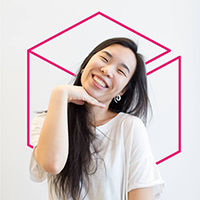
Carol Cheong
Majors: Art History and Studio
What factors contributed to you choosing your program(s)?
I was a transfer student from the Mississauga campus who specialized in Art and Art History so when it came to choosing my program at the Scarborough campus it only made sense to continue what I started. The only difference being the program at Mississauga was one joint program with Sheridan College whereas Scarborough had it in two separate programs.
Can you describe your program(s)?
Both programs have their own challenges and are demanding of different things. The Art History program is taught by professionals in the field who incorporates their experience and skills gained; the professors are constantly encouraging students to become engaged in the art communities, to go out and spend the time in museums and galleries in order to fully experience the artwork and visually see what is being studied. The time spent on reading textbooks and attending lectures are not enough to grasp the lessons being taught. There are always more that can be done to understand the histories and how Art came to be now. In comparison, the Studio program is very hands-on. In the first 2-3 years the students are required to follow different disciplines to explore all the technical ways of making art. The experience during that period allows them to not only explore what can be used and how, but also realize what they are capable of creating. The professors are there as mentors and guides while the creative process is left for students to develop.
What tips/advice can you provide to students just starting or considering this program(s)?
- To explore the city. You will find not only inspiration in the places you go but also learn the history of places. In this process you will gain knowledge and create relationships that can become major influences for you.
- Attend artist talks and gallery opening/closing receptions. Whether you are studying Art History or Studio it is important to hear from present-day artists to learn their process and influence. There is always a connection between the present and the past, in talking to the artmakers you get the chance at seeing how they process experience and transform it into art.
- Critiques are important and you need to be involved. It is understandable to be nervous during critiques and even intimidated but that is not an excuse for not participating. Everyone deserves to know what the public feels about their creation and if you are willing to help carry the conversation, they in turn will do the same for you. When there is no constructive criticism or praise for what was successful in an artwork, not only do your peers lose an opportunity for learning about themselves, but you also lose an opportunity to become more articulate in explaining and understanding art.
What will you do with your degree after graduation? (Future plans?)
Personally, my undergrad has been a long learning process that is allowing me to understand my role as an active artmaker and participant in the art community. With my double major I can continue to pursue history or overlap into museum studies to learn the workings of a museum or gallery. I plan to pursue art full-time and to continue creating, to complete a Masters in Fine Arts and become an exhibiting artist.
What has your academic journey during your time been like as you progress toward graduation?
After transferring to the Scarborough campus my first and second year had been full of studying, getting what needed to be done done, and going to school was just in-and-out. I did not want to spend a lot of time at school and my goal was to complete the task at hand to graduate. In my third and fourth year here my studio projects were becoming larger in scale and I did not have that kind of space at home. As a result, I spent all of my time at school whenever possible and from that it allowed me to share experiences with my peers and create strong relationships with other studio majors. It also was not until the latter years that my being at school brought me to: a work-study position for the Doris McCarthy Gallery; I began exhibiting my artworks in group, class, and solo shows, and I became the Studio Director for ArtSideOut 2016. There has been so much to gain throughout the years and when I took the time to be involved and invested in the University, it has always allowed me to grow as an individual.